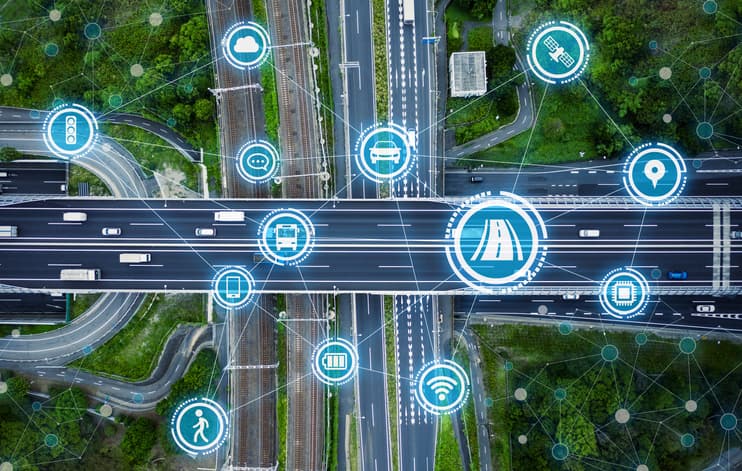By Henrik Christensen, PhD, Qualcomm Chancellor's Chair in Robot Systems, Director Contextual Robotics, UC San Diego; ROBO Global Strategic Advisor
When most people think about AI and transportation, their minds go immediately to self-driving cars. But while the delivery of truly autonomous vehicles that are safe and reliable in all environments, all of the time, remains in the relatively distant future, AI is already being applied in a variety of applications that are poised to transform our lives on the road—no matter who is doing the driving. For users of these technologies (which will inevitably include us all) and investors who are hoping to hop on board this rapidly accelerating opportunity, here are just some of the key innovations that are either here today or are just around the corner:
- Smart lights
Adaptive traffic lights have been improving the flow of traffic for decades by altering how often traffic lights change based on typical traffic patterns. AI is helping to take that idea to the next level with AI-managed traffic lights and streetlights. IBM’s smart traffic lights use machine vision to look at real-time traffic flow. The connected system then applies computer algorithms to determine when each signal should change to optimize the flow of traffic in real time. Similar to navigation apps like Waze, the system’s ability to analyze actual traffic rather than traffic pattern averages promises to reduce traffic congestion and commute times.Current, a subsidiary of General Electric, is also putting the power of machine vision to work, in this case embedding AI-enabled cameras into a vast network of streetlights that do much more than illuminate streets, sidewalks, and parking lots across San Diego. Using a machine-vision camera to capture images in a wide radius around each light, the company is building a database of valuable, real-time information 24 hours a day. That information is then used to point drivers to vacant parking spots, alert police to illegally parked cars, and even identify dangerous intersections that need to be redesigned to improve pedestrian and driver safety. - Advanced driver assistance
While fully autonomous vehicles may be the ultimate goal for the transportation industry, advanced driver assistance systems may prove even more useful at improving the driving experience and reducing collisions. Systems from technology providers like Mobileye and Nvidia are now available from a growing number of automakers, including Mercedes, Mitsubishi, Nissan, Subaru, and Tesla. Using machine vision, sensors, and other emerging AI technologies, these systems make it easier for drivers to park, keep them from drifting out of lanes, detect hazards such as pedestrians and stopped vehicles, recognize speed limit and other road signs, and even force a hard stop to avoid a potential collision.
RELATED: Who's that knocking at the door? AI has finally come home
- Driver monitoring
Texting while driving puts lives at risk, but there are many other driver activities that cause accidents, injuries, and fatalities every day. Logistics and delivery providers with large fleets—including FedEx, UPS, and USPS—are now using on-board driver monitoring systems to add a whole new level of security and safety by using AI to detect behavior that deviates from the norm. The systems can determine if drivers are texting or talking on the phone, paying attention to the road, speeding, and more. Considering that up to 75% of road accidents are caused by distracted drivers, this type of AI-enabled driver monitoring is expected to not only improve logistics efficiency, but also improve overall road safety. And don’t be surprised if self-driving trucks for package deliveries become the first fully autonomous vehicles to hit the road: the US Postal Service recently contracted TuSimple to test-run its self-driving trucks. If their efforts are successful, expect to see other commercial fleets follow quickly in their footsteps. - Smart cities
Using the powerful combination of 5G and the Internet of Things (IoT) to connect and communicate across citywide networks, planners are beginning to drive vital efficiencies and improve the quality of life for residents and visitors of smart cities around the world. In Amsterdam, real-time data from the IoT is being used to monitor things such as traffic flow, energy use, and public safety, and then make needed adjustments. Smart trashcans in Baltimore and Boston communicate how full they are at any given time, making it easier to create more efficient routes for sanitation workers. - Transportation
Private transportation providers like Lyft and Uber have already put AI to work to provide riders with actual pick-up times, images of their assigned car and driver, and accurate arrival times. Using AI and 5G, they will soon be able to add conveniences such as positioning riders in the best possible locations for faster pickup and coordinating smarter driving pools. In cities across the US, AI is enabling public transportation services to cut commute times by detecting long queues at train and bus stations and using that data to increase the number of cars and coaches to reduce congestion. At the University of Michigan, the Mcity Driverless Shuttle, an all-electric bus from French automaker NAVYA, uses Lidar sensors and GPS to shuttle students across campus without a human driver. Similar systems are also being tested at the Texas A&M campus.
From moving people to delivering goods, AI technologies such as Lidar sensors, machine vision, machine learning, adaptive planning, and IoT are already beginning to have a dramatic impact on how we get from one place to another and how goods of all kinds are delivered from the factory floor to the consumer’s front door. AI’s ability to accelerate and innovate transportation—and the opportunity for investors to make the most of a technology revolution that is already in process—is nothing short of massive. Are you on board?
Also in this series by Henrik Christensen, PhD:

